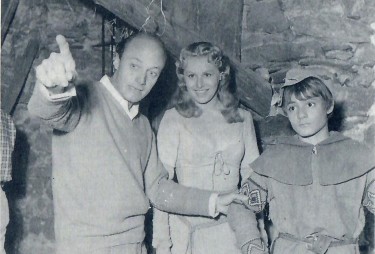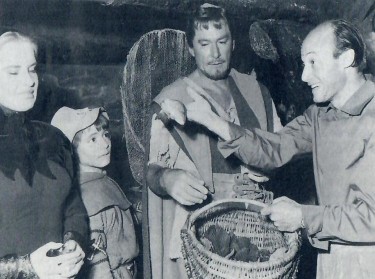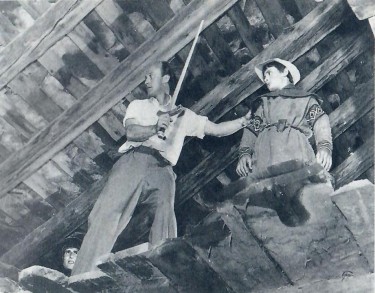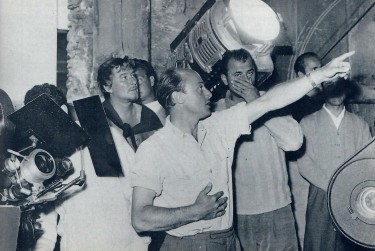As most of us know, this big Cinemascope Film was never completed and only around 15 to 20 minutes of the film was shot and exists somewhere on celluloid.
Errol Flynn had a dream of rivalling Hollywood and making a big Wide Screen picture that would rival anything on the market. He may have pulled it off if the money had not run out – he did invest a huge amount in the project.
He employed Jack Cardiff the world renowned cinematographer to direct this one – a village was built in Austria, and they then went to work and from what a friend told me, the results were excellent as far as they went.
Film Production began on 14th June 1953 with a three month shooting schedule. However after three weeks filming at one of the most beautiful locations in Italy, the production ran out of money but Jack Cardiff and others continued without pay until the film was stopped on 31st August 1953.
The film never restarted and nobody was ever paid.
Errol Flynn relied heavily on Jack Cardiff, who was well up for this in his directorial debut – things like tests he did in Rome – one of those tests was of the famous apple shooting sequence, but this was never filmed.
This would have been only the third film released in Cinemascope – and at this time even The Robe had not been released to the public.
Jack Cardiff says that filming in Cinemascope gave him many difficulties – one of which was the fact that it could not be in focus at any nearer that 7 ft which meant that any intimate close-ups were either impossible or very difficult. He did some close up tests though on Bruce Cabot which meant intense light in the studio which nearly fried the actor – but it did produce results.
On top of this the very wide screen meant that even if you got a close up, you still had to fill either side of the screen with something.
As well as coping with Cinemascope, a new colour process had taken on called Esatmancolor, which was cheaper than Technicolor and easier to use so it did become popular. However what was not known at that time is that Eastmancolor prints faded badly in around 5 to 10 years which Technicolor did not.
The film script, Jack Cardiff describes it as a very good script, was written by John Dighton an Ealing scriptwriter.
The village was built in the mountain location – and so all would seem to be well organised but for the finance situation.
Jack Cardiff had filmed the fight in the smithy and also completed the fight between Errol Flynn and Bruce Cabot in a lake – this was the last sequence to be filmed.
My own thoughts are that Errol Flynn, although a vocal critic of the personnel at the top of the major American Studios, had nowhere near the financial expertise that they had, and his fund raising choices of personnel were at best naïve.
This led to the downfall of the project – and what a hit they would have had with something on this scale – and at that time -with the new screen format, colour, beautiful locations, a good script and top actors – Errol Flynn was still a very big name in films and very popular at the Box Office.
I have enjoyed writing this on Errol Flynn and Director Jack Cardiff and also the classic that never was ‘William Tell’ 1953





Very interesting David and it is something I just did not know. When I read about Jack Cardiff’s problems with Cinemascope and focusing the camera it did surprise me although I had heard that the width of the screen made Directors very conscious of having to fill it on each side and that did prove difficult when making a non epic film. It suited films like ‘The Robe’ and would certainly have suited ‘The Story of William Tell’ I think.
You did not make any comment about the film but then again, none of us has ever seen it. I wish I could see what was filmed.
I remember seeing a television documentary about Errol Flynn some years ago that included a scene from William Tell of Errol Flynn and the boy who played his screen son walking along a woodland path and talking. I’ve also read that somewhere, there is about half an hour of CinemaScope / Eastman Color film from it that was all they managed to put in the can before the money ran out. Errol should have tried to get a big company like MGM to finance the picture. They weren’t short of a dollar or two, instead of trying to finance it all by himself.
I think you are spot on there, David. If he had got MGM on board, then we could have seen a really good film and I would guess a profitable one at that. He seemed to have everything right though here except for the obvious – that is the finance for the film. Also MGM would have had the distribution side of it tied up – and that is another essential – certainly in those days and maybe even today. Neil
… [Trackback]
[…] Read More Info here on that Topic: filmsofthefifties.com/the-story-of-william-tell-1953-errol-flynn/ […]
… [Trackback]
[…] Find More Info here to that Topic: filmsofthefifties.com/the-story-of-william-tell-1953-errol-flynn/ […]
I don’t think the title of your article matches the content lol. Just kidding, mainly because I had some doubts after reading the article.